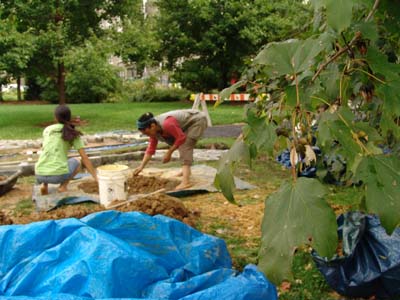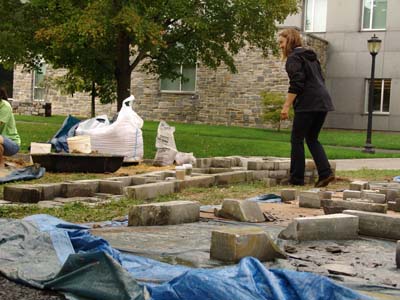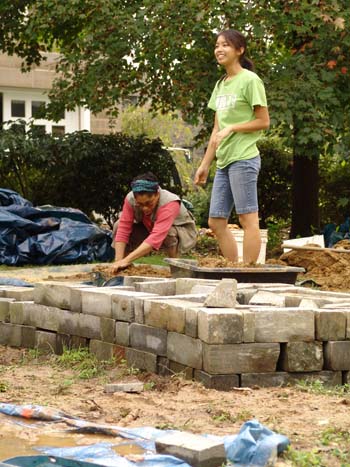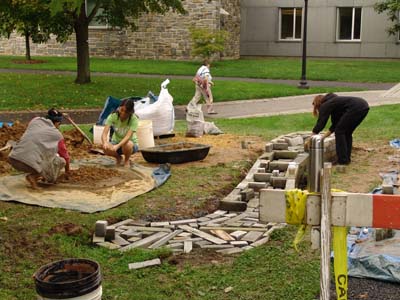Playing in the Dirt: a Twist
 All gardeners like to play in the dirt. Well, the latest art installation on the grounds of the Scott Arboretum takes playing in the dirt to a whole new level. This project entails building walls out of dirt. Starting this week and continuing until October 7th, students, volunteers, and community members will help artist Massey Burke, 2000 alumni of Swarthmore College, construct an earthen wall.
All gardeners like to play in the dirt. Well, the latest art installation on the grounds of the Scott Arboretum takes playing in the dirt to a whole new level. This project entails building walls out of dirt. Starting this week and continuing until October 7th, students, volunteers, and community members will help artist Massey Burke, 2000 alumni of Swarthmore College, construct an earthen wall.

Massey Burke prepares the site for the construction of the Beardsley Earthen Wall. photo credit: R. Robert
Massey Burke has been teaching and practicing natural building techniques for seven years. She has built homes to park benches from clay soil, straw, and sand. “Most Americans have never lived in anything truly hand-built,” Burke says. “We are so accustomed to stick-frame structures it has come to seem normal. We don’t realize that most of the world does not live this way, that in most other countries people build with whatever is at hand.”
In 2009, Sasha Rabin and Massey Burke founded the company Vertical Clay. Vertical Clay works primarily with clay soils, local biodegradable fibers, aggregate, found and recycled materials employing the techniques of adobe, cob, earthbag, superadobe, straw clay, clay wattle, wattle and daub, earth and lime plasters, earthen floors and certain kinds of bamboo and strawbale construction.
Burke notes the sustainability of earthen construction, remarking that earthen walls weather slowly, don’t burn, can’t be eaten by insects, and can be reused. With an anticipated life of two years, the Beardsley Earthen Wall is located behind Beardsley Hall near the Viburnum Collection.

Professor Syd Carpenter and student volunteer prepare clay for construction of the Beardsley Earthen Wall. photo credit: R. Robert
Massey was invited to construct this distinctive wall by Professor of Studio Art, Syd Carpenter. While over 30 community members, Arboretum volunteers, and students from across campus are helping to “play in the dirt” and construct this earthen wall, Carpenter’s class, entitled The Container as Architecture, have tackled this installation as a class project.
Massey celebrated “I would love to come work on such a project at Swarthmore. What you propose unifies most of why I practice earthen construction – its capacity for artistic expression, its ability to provide a tangible focus for sustainability dialogue, its interdisciplinary nature and its accessibility to what I call “unconventional work crews (students, volunteers, communities). “

You can see the foundation of the Beardsley Earthen Wall. photo credit: R. Robert
Carpenter commented that the rain has not damped the construction efforts. The rain doesn’t hurt the clay and the volunteers dry out. Come experience the art of natural building at the Scott Arboretum and see a whole new way to get your hands dirty in the garden.





Becky Robert
Posted at 14:09h, 05 OctoberVisit our facebook page to see photos of the wall’s progress. https://www.facebook.com/ScottArboretum